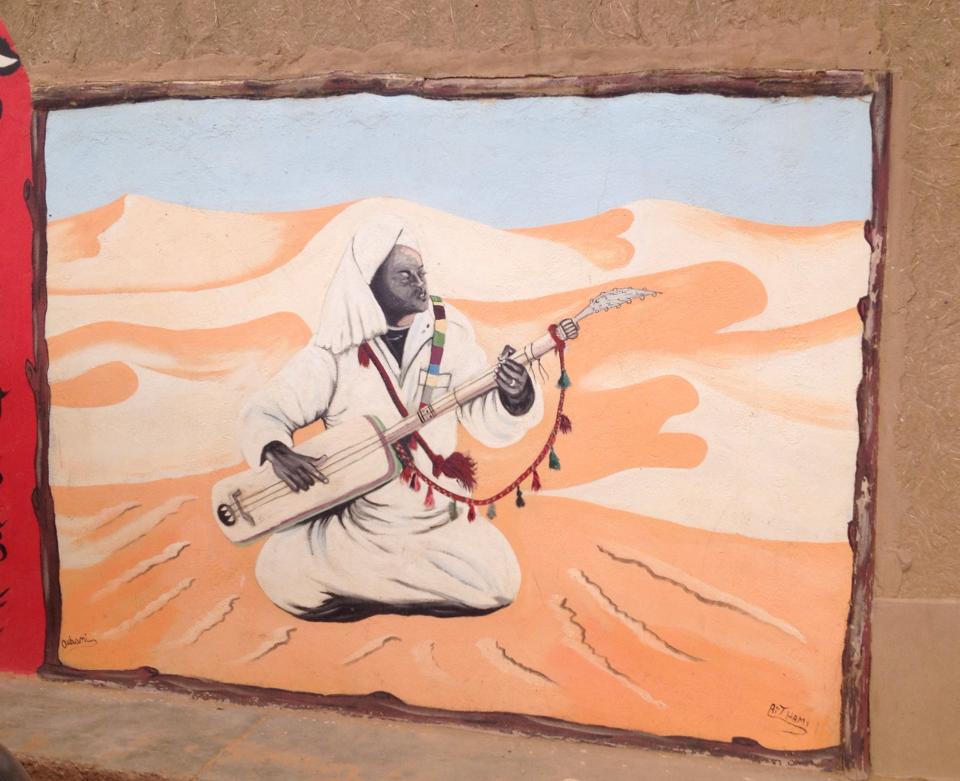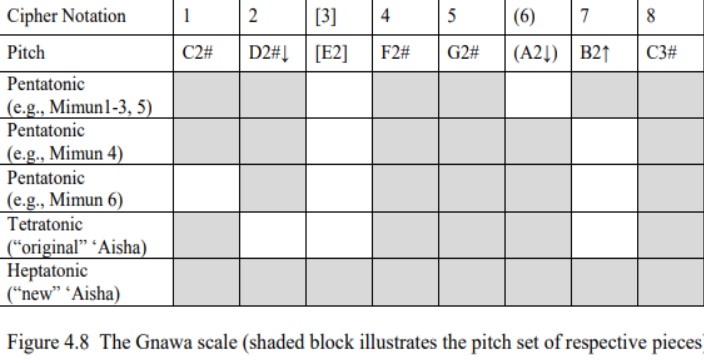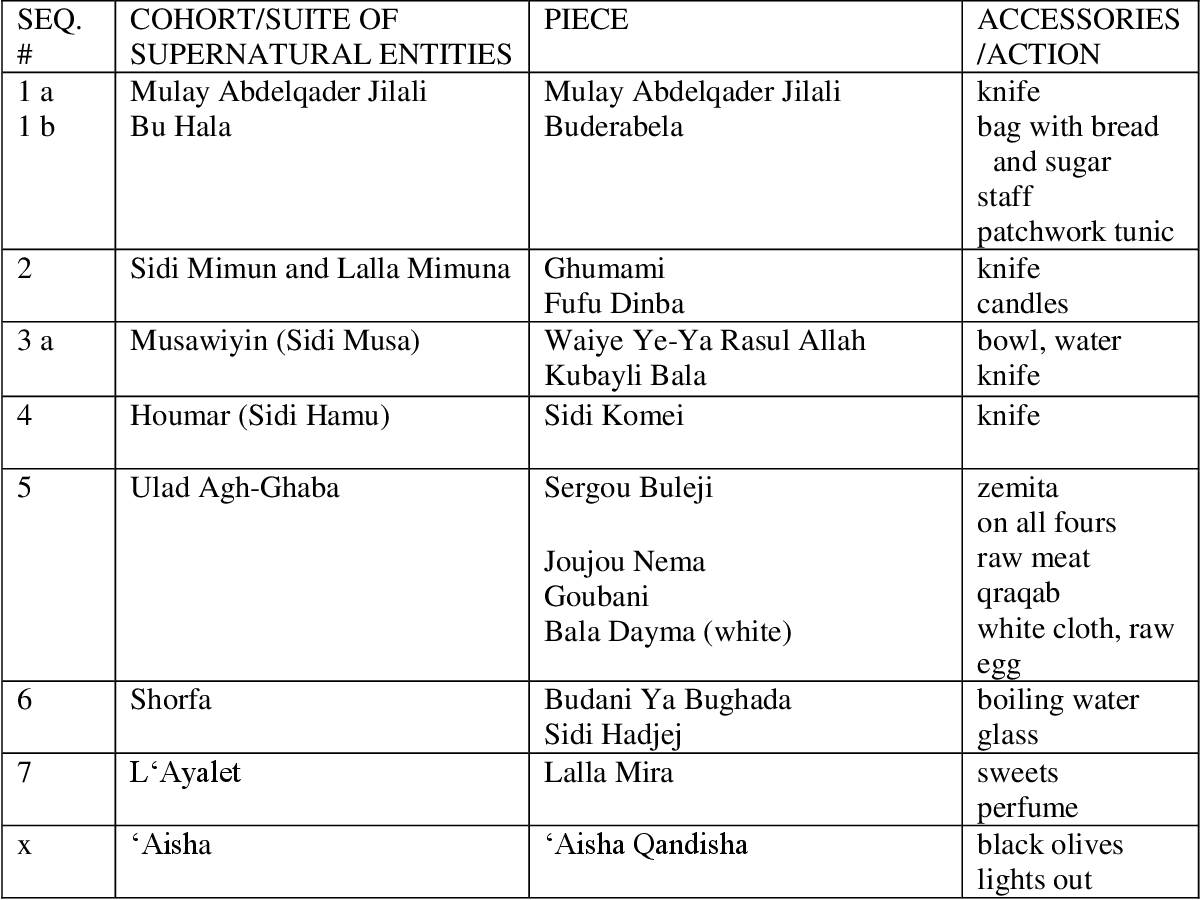
Merzouga, southeastern Morocco (one of the first Gnawa Sahara stops)
Next Post: Blackness

Merzouga, southeastern Morocco (one of the first Gnawa Sahara stops)
NOTE: Technical issues arose last time, but there'll be screen-sharing
so you can view what I do!
There is also a chance to try the Polyrhythm
Pattern Generator and make
your very own Gnawa sequence digitally.
Hear 'Lalla Aicha' in the heptatonic scale here!
DIASPORIC AFRICAN POWER GNAWA
LIVE STREAM I (![]() )
GNAWA LIVE STREAM III (
)
GNAWA LIVE STREAM III (![]() ) GNAWA LIVE STREAM IV
(
) GNAWA LIVE STREAM IV
(![]() )
GNAWA LIVE STREAM V (
)
GNAWA LIVE STREAM V (![]() )
)
GNAWA LIVE STREAM VI (![]() )
GNAWA LIVE STREAM VII (
)
GNAWA LIVE STREAM VII (![]() )
GNAWA LIVE STREAM VIII
(
)
GNAWA LIVE STREAM VIII
(![]() )
)

(Music
of the Gnawa of Morocco: Evolving Spaces and Times, pg. 135)
Chama Mechtaly is an Amazigh-Jewish
artist/human rights
activist with a beautiful perspective and background.
She painted Lalla Mimouna, and
7th-century Queen Kahena
who was also Amazigh and proud in her Judaism.

Morenica: Femme et Foi en Méditerranée (“Women and Faith in the
Mediterranean”)
"Mimouna is also a festive occasion
celebrated by Moroccan Jews
at the end of Passover where Muslim
neighbors traditionally visit
Jewish homes carrying baked goods and leavened foods
that aren’t allowed in Jewish homes during Passover.
The story of Passover is a story
of slavery, freedom, desert
crossing and miracles, very similar to that of Gnaoua."
Gnawa Ethnicity and Dual Consciousness/Meaning
Gnawa ethnicity and traditions have primarily
been Central and West African, and partially
indigenous North African.
They were banned by Moulay Abdelaziz
for this reason (text [Villes et tribus du Maroc,
vol. III-VIè, Rabat et sa région]).
But persistent, cultural influences
via regional communities
(plus a traumatic migration route)
remain through memory
and song (The Space of Africanness).
Gnawa tell us about old Malian Empire cities, Tombouctou,
tribal dances, saints and past accomplishments or hardships.
Gnawa originally lived in modern
Burkina Faso, Ghana, Mauritania,
Mali, Senegambia and even Morocco (Afropop).
They (the 11th century onward) were treated as
enslaved collateral along caravan
routes, especially after expulsion from Muslim lands for
Multiple groups and languages are part
of Gnawa: Amazigh (Holidway),
Sahelian to the extent that these languages and sounds:
takamba, tende, gulu drums affected its
name and structure; French and
Spanish from each colonial era; Sephardic,
northern African Jewish.
Remember, it only takes 52 days to reach southeastern Morocco from Timbuktu.
MIMOUNA
Mimouna is both a holiday feast after Pesach (Passover) in Judaism:
the emancipation of Israeli refugees in Egypt by Moses, or Sidi Musa
after God spared their first-born children during
the night...and a Gnawa melk or spirit.
Mimouna in Gnawa has a West African link too.
You say 'Tarbakhu utsa' adu' and share five of
several symbolically bountiful items.
Each custom for Mimouna centers the night and
how it can be a joyful yet observant time:
both the Gnawa lila and Jewish Seder
during the month Nissan.
The initial Passover day in 2020 is
April 9 (April 8 for Israel)!
And Gnawis' first main feast is during
Sha'aban before Ramadan,
April 1 to April 30.
Both feasts feature similar items: fruits
like dates and figs (Haaretz/
The Nomadic Alternative, spreads and
milk under certain conditions,
preserved shank bones from animal meat to respect
sacrifice, unsalted bread (Les Gnaoua...).
There's a fascinating 20-year-old thesis about this,
The Cuisine of Morocco: Origins and Ritual Significance.
What's a ke'ara (Seder plate)?
A platter in Gnawa public and private ceremonies.

(Music
of the Gnawa of Morocco: Evolving Spaces and Times)
Moroccan Jews have an affinity to Mimouna
alongside Gnawa because Lalla
Mimouna is a guardian
she symbolizes the door to Sudan).
Bambara could be a main ancestor too,
since Gnawi Mohcine el Kostany
understands 'gna' to mean village.
Group Gnaouas de Tizounine sing in
Amazigh, Darija and Bambara.
This is the Draa area, four hours from Sidi Jilali's zawiya.
Miloud Taifi is an Amazigh-Moroccan
scholar who researched further
(Dictionnaire Tamazight-Amazigh: Parlers du Maroc Central).
Insight arrives through his Gnawa
etymology, since ignawen
throughout the country means dark,
thunder or the opposite: mute.
Pierre-Alain Claisse's translation of Maurice Delafosse's 1912
Haut-Sénégal-Niger (Soudan français) reveals that Kenawa was
interchangeable with Gnawa as a
reference to darker-skinned
African people.
And it's a Hausa word alongside others in the tradition.
Did you know akal-ignawen means 'land of the Black people'?
Kufan Kanawa is a medieval site in former Kano, Niger
(Ethnoarchaelogy in the Zinder Region).
Nigerien biram master or Malam Maman Barka.
He is Toubou, a northeastern Nigerien
and Saharan ethnicity who roam
ancestral provinces through the Sahel, Muslim
like the Fula, Maninke and others.
Gnawa Diaspora on a Map and More Ritual Details
These ancient Moroccan cities are where many
Gnawa live, like Agadir, Merzouga,
Casablanca, Fes, Khamlia, Essaouira,
Marrakech, Rabat, Tangier.
Different ones feature their own styles: Marsaoui (Essaouira),
Marrakchi (Marrakech) with its daqa
marrakchi trademark clapping,
slower guembri playing. Issawa has more sway here.
Who are the maallems of each city?
Last week we mentioned Abdenbi el Gadari (Marrakech),
Maalems Abdellah el Gourd (Tangier), Paco
and Mahmoud Guinia (Essaouira)
who are no longer with us.
Trace their legacy from the family tree to other musicians,
like Jimi Hendrix who learned a different roots style,
and of course Gnawa as a whole.
There's the Boussous (originally Chadean), late Maalem Hmida and his son
Hassan from Casablanca. Hmida would play with Randy Weston (true story).
Read Maalem Hassan's Medi1 Radio interview.
Maalems Abdelkader and Abderrahim Benthami (father and son)
are Casablancan. Asmaa and Rachid Hamzaoui are too.
Maalem Hamid el Kasri's name comes from
the northern city Ksar el Kbir.
This should clear details up.
Salamatu plays the Hausa gurmi, or
gurumi in Niger.
A guembri parent? You bet.
Music from the Villages of Northeastern Nigeria
Perhaps Guinea, Mali, Niger, Nigeria and Senegal
were the most prominent places
for this diaspora. Much like Mimouna, the specific truth is lost
(but not fully) to time. As for the Jewish diaspora in Morocco?
They have lived there for over
2,500 yearsnow, since 587 B.C.E.
when Babylon destroyed Jerusalem
(an event that Black Rastafarians
and the Abrahamic faiths reference occasionally).
Sephardic Jewish bonds with maallems
and neighborly Muslims
led to Saturday songs, Sebitiyin, that were composed pre-Shabbat.
They shared mazune (fruit or
vegetable jam), moufleta (honey
pancakes), beloved mint tea and their stories.
Innov Gnawa (Maalem Hassan Ben Jaafar,
Nawfal Atiq, Samir LanGus,
Ahmed Jeriouda, Amino Belyamani,
Said Bourhana) dedicated a
performance to this Gnawa
(African/Sufi)-Judaic confluence.
![]()
Association Mimouna MIMOUNA Mimouna: Passover's Best-Kept and Sweetest Tradition The Visible And The Invisible: The 14th Festival of Essaouira Gnaoua et Musiques du Monde
African Slaves in Islamic Lands Moroc 'N Roll: Gnawa Style Who Are Gnaoua CyberGnawas (Archived)